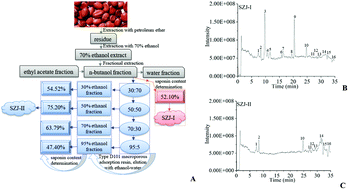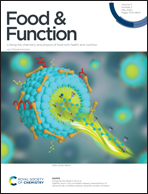Targets and underlying mechanisms related to the sedative and hypnotic activities of saponin extracts from semen Ziziphus jujube†‡
Abstract
Semen Ziziphus jujube (SZJ) has been widely consumed because it is recognized as edible in China to treat insomnia disorders. However, the underlying mechanisms and potential therapeutic targets remain obscure. SZJ-I and SZJ-II with a saponin content of 52.10% and 75.20%, respectively, were extracted from SZJ. LC-MS analysis presented quite different chemical profiles of SZJ-I and SZJ-II. Mice with p-chlorophenylalanine (PCPA)-induced insomnia were used to comparatively and systematically test the sedative-hypnotic activities of SZJ-I and SZJ-II. In vivo behavioral tests revealed that SZJ-I and SZJ-II significantly shortened the immobility time and potentiated sodium pentobarbital-induced sleep. SZJ-II with a higher saponin content showed greater potency than SZJ-I. SZJ-I and SZJ-II also protected against PCPA-triggered neuropathological damages in the brain. Concentrations of 5-hydroxytryptamine (5-HT), dopamine (DA), noradrenaline (NE), glutamate (Glu), interleukin-6 (IL-6), interleukin-1β (IL-1β), nitric oxide (NO) and prostaglandin D2 (PGD2) in plasma were significantly affected by SZJ-I and SZJ-II application. SZJ-I and SZJ-II also exhibited differential modulation of 5-hydroxytryptamine 1A (5-HT1A), 5-hydroxytryptamine 2A (5-HT2A), GABAA receptor α2 (GABAARα2), GABAA receptor α3 (GABAARα3), glutamic acid decarboxylase (GAD) 65/67, IL-6 and IL-1β expression in the hypothalamus and hippocampus. SZJ-I and SZJ-II might exert excellent sedative-hypnotic effects through multiple mechanisms that worked simultaneously. SZJ-I and especially SZJ-II are promising candidates for relieving insomnia.

- This article is part of the themed collection: Food & Function Recent HOT articles


 Please wait while we load your content...
Please wait while we load your content...